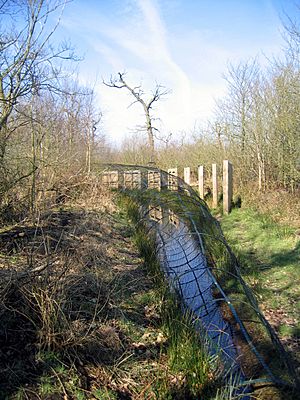Hale Duck Decoy facts for kids
Hale Duck Decoy is a special place in Hale, Cheshire, England. It's a type of trap used long ago to catch wild ducks. Today, it's also a nature reserve where animals and plants are protected. This important site is known as a Scheduled Ancient Monument and a Site of Special Scientific Interest. It belongs to the Fleetwood-Hesketh family but is looked after by Halton Borough Council and a team of helpful volunteers.
History of the Duck Decoy
We don't know the exact year Hale Duck Decoy was built. But clues suggest it was made in the 1600s. Records show that in 1754, Colonel J. Blackburne, who owned it then, had it fixed up and made better. The decoy was part of the large Hale Hall estate. The Ireland Blackburne family owned this estate for many years.
In the 1930s, the Fleetwood-Hesketh family bought the estate. However, the decoy was not kept in good condition for a while. In 1975, work began to restore it. It then became a local nature reserve. Different groups helped manage the site. They cleaned it up, built a swing bridge, and planted new trees. Volunteers even rebuilt the gamekeeper's hut in the early 1980s.
In February 1990, the decoy was damaged by a big flood. This happened because of a very high tide and strong winds. Salt water covered the area, killing trees and other wildlife. After the flood, the central pond and moat were cleaned out. Mud was placed on the banks to make them higher.
Halton Borough Council took over managing the decoy in 2000. In 2004, a group of volunteers called the Friends of Pickerings Pasture received a grant. They used it to fix the gamekeeper's hut. This made it a better place for visitors to learn about the decoy. In 2010, the Council changed how it managed the site. The volunteers continued to play a big role. In December 2013, there was another worry about flooding, but luckily, the damage was small.
What the Duck Decoy Looks Like
The nature reserve covers a large area. The decoy itself has a central pond. Five narrow arms, called pipes, spread out from this pond. This makes the decoy look a bit like a pentagon. Trees grow between these pipes.
A wide moat, about 16 feet across, surrounds the whole area. You can cross this moat using a swing bridge. Inside the site, you'll find the restored gamekeeper's hut. It has displays and information for visitors. There's also an old stone near where a boat house used to be. It has "XRC: 63" carved into it. Some people think this means it was made in the year 1633.
Hale Duck Decoy Today
Today, the duck decoy is looked after by a group of volunteers. They are called The Friends of Pickerings Pasture and Hale Duck Decoy. The site is still a Scheduled Ancient Monument. This means it's a very important historical place. The trees on the site are also protected. The decoy and the salt marsh around it are a Site of Special Scientific Interest. This means they are important for their wildlife.
The Friends of Pickerings Pasture arrange guided walks for people who want to visit. In November 2018, the site was added to Historic England's Heritage at Risk list. This means it needed more care to protect it for the future.


